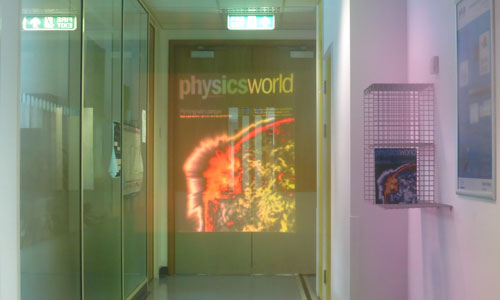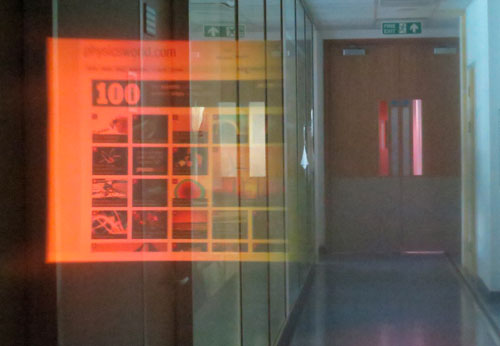
Holographic view: The August 2014 issue of Physics World, seen through the NPL device. (Courtesy: NPL/Richard Stevens)
By Tushna Commissariat
Some of you may remember a news story I wrote last month that looked at a new optical gadget that uses a holographic waveguide to augment reality. The device hopes to transform the wearable-display market – it allows users to overlay full-colour, 3D, high-definition images into their normal line of sight, thereby interacting with their surroundings. The waveguide was developed by UK-based company TruLife Optics, along with researchers from the adaptive-optics group at the National Physical Laboratory (NPL) near London.
A few weeks ago, I had the good fortune to visit Simon Hall’s lab at NPL and have a play with a prototype of the waveguide that was fitted into a frame with an input that was connected to Hall’s computer. I was suitably impressed with what I saw…everything from Hall’s desktop to a webpage to a YouTube clip of The Lego Movie flashed up in front of my eyes, superimposed over the lab around me. Although the colours are still fairly basic (RGB only) the images were perfectly in focus and I didn’t have to squint or strain to read or watch any of it.
While there, I couldn’t help but wonder what the Physics World magazine and website might look like to our future readers, who may very well use some such device in years to come. When I mentioned this to Hall, he kindly suggested that he and his colleague Richard Stevens could take a few pictures for us. Above is an image of the current August issue of the magazine seen through the device, with a paper copy propped up alongside in one of the many corridors at NPL. Below is a picture of our 100 Second Science webpage seen through the device. Both images were taken using the prototype – so take a good look at what the future of Physics World looks like and get ready to read your copy on the go!

Futuristic view: the 100 Second Science page. (Courtesy: NPL/Richard Stevens)
I thought this was pretty neat when you first described it. However, if I was going to use it, it would be nice to be able to vary, what?, the translucency? Hard to read the magazine with the world filtering in (which my brain takes care of when I am reading what I hold in my hand on on my monitor display or TV). And, one has to admit, hard to pay attention to the world, with virtual advertisements, dashboards, and signal displays popping up all around. Ha, maybe I am too old and one has to learn this adroitness at a very young age :-}
Trackback: Blog - physicsworld.com